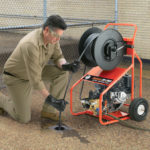So, picture this: you’re kneeling in wet grass next to a clean out and shoving your Gen-Eye pipe inspection camera system slowly down into the drain. The push rod is stiff, but slippery, and it is just flexible enough to permit you to negotiate the 90-degree turn at the bottom of the clean out and coax it in the direction of the street. The yard seems to be approximately the size of Rhode Island, with a driveway, several trees and an overgrown, but earnest, attempt at landscaping between you and the property line. The customer’s toilets and drains have been backing up almost every time it rains and you’ve confirmed everything between the house and the clean out is flowing normally. Your problem lies under the front yard, and it certainly involves a broken or leaking pipe. In a flash of insight, it occurs to you that you are propelling a video camera into what is certainly a damaged sewer pipe. What could possibly go wrong?
As it turns out, plenty. Although this imaginary scenario seems relatively safe and controlled compared to some plumbing camera applications I’ve heard about over the years, contractors damage their sewer cameras in situations like this every day. It’s easy to do and it is expensive to correct, so let’s take a look at the two most usual suspects and see what we can learn.
Kinking the push rod as you thrust it into the pipe
According to camera repair centers, most kinks occur in the first few feet of the push rod. This seems to happen when the contractor, or more likely the contractor’s assistant, shoves the push rod into the pipe with a tad too much enthusiasm. It can also happen when the operator decides to stand instead of kneel or crouch next to the drain opening. If you give it too much room to roam, the push rod tends to bow out and kink right before your eyes. Embarrassing…and expensive. Depending on the brand and the severity of the problem, a re-termination on a standard push rod in the U.S. can cost anywhere from $200 to $600. My advice is to keep your hands low, as close to the drain as possible and slow down! Use short, fast motions to get around a bend and watch where you’re going. Pay attention!
Damaging the sewer camera head
The head of your sewer camera is the most important and expensive part of the pipe inspection system, and it is usually the most vulnerable. Most of the damaged camera heads that arrive at repair centers have a cracked lens cover or light ring, which is presumably the result of being used as incredibly expensive battering rams. The video camera in your pipe inspection system is very similar to the one you used to record your cousin Edna’s wedding. It’s probably been sealed in a stainless steel protective case behind a sapphire lens cap cover, but the guts are the same. The LED lights are hidden behind bulletproof Plexiglas and the whole thing is either pipe-threaded or epoxied to the end of the push rod so it’s sealed up like an Egyptian tomb. Sounds impressive, but all of that is no defense for an overly enthusiastic drain cleaner. My advice is to not use your sewer camera system as a drain cleaner! You have other tools in your truck that are much better suited for that task, and they are much less expensive to repair. Keep your eyes on the monitor! If the camera head is approaching a break in the pipe, a foreign object or is underwater, do yourself a favor and stop. Be careful. Pay attention!
Are there other calamities that can befall your sewer camera system besides these two? Absolutely. From kinking the pushrod a hundred feet down the line, to accidentally cutting off the camera head when sawing through the pipe, there are dozens of problems that can pop up in the life of a sewer camera system. However, addressing the above will greatly decrease the odds of having a plumbing camera-related mishap ruin your day.
Over the years, we’ve noticed that some contractors never break their camera systems, and others seem particularly hard on them. Most drain cleaners and plumbers fall in the middle range and experience only occasional problems. The important take away here is that repair centers see a clear relationship between technique and frequency of repairs. Live and learn!
For more information on any of our innovative pipe inspection cameras, call the Drain Brains® at General at 800-245-6200, or email us at [email protected]. You can also request literature on any of our handy sewer camera systems right here. View our sewer cameras for professional use by following this link. Lastly, find a distributor near you where you can buy our rugged diagnostic tools as well as our other drain cleaning equipment.



